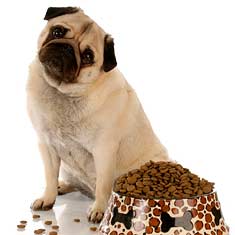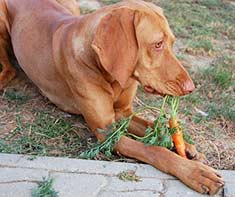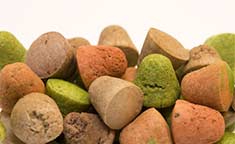Dog Nutrition - Part 2: Basic Nutritional Requirements of the Canine
This article is the second in our series on dog nutrition. Part one covered covered the basics of commercial dog food, while future articles will discuss the differences between prescription, premium, and grocery-store dog food; the pros and cons of making homemade dog food; and foods that should be avoided.

Just as humans, dogs need proteins, carbohydrates, fats, vitamins, minerals, and water. However, since they lack the opposable thumbs necessary to open food packages, dogs must rely on us to provide for their nutritional needs. Most commercial dog foods supply a dog with the necessary nutrients, but they may not be in the correct amounts or may not be easily digestible in some of the cheaper brands. This article will give you a basis for evaluating the food your dog is getting so you can see if he is getting the best nutrition possible.
Protein in Dog Food
Proteins are made up of building blocks called amino acids. They are necessary because they form the enzymes needed to break down food into energy that the dog can use. They also form the basis of hormones that make the dog's body processes work as they should. While dogs can manufacture some of the needed amino acids in their bodies, others must be supplied by food.
Protein can be derived from plant sources such as soybeans or from animal sources in meat and dairy products. In most cases, plant sources of protein are harder for a dog to digest. However, they are cheaper for pet food manufacturers to purchase, so many dog foods use plant-based proteins nearly exclusively. Puppies and working dogs have huge protein requirements and are often fed high-protein diets. However, adult non-working dogs should not be fed special high-protein diets, as too much protein can cause kidney disease.
Carbohydrates in Dog Food
About 50% of your dog's food will likely come from carbohydrates. However, all carbohydrates are not created equal. Dogs can digest almost all of the carbohydrates in white rice, but wheat, corn, and oats may pass about 20% of their nutrients through the small intestine without being absorbed. These leftovers are fermented in the large bowel and can cause flatulence.
Some carbohydrates are used in dog food solely to provide filler. These elements are provided only to make the dog feel full, but they provide no nutritional value.
Fats in Dog Food
In the United States, the "thin-is-in" culture has made fat a dirty word. It is true that fats are, ounce for ounce, higher in calories than carbohydrates and proteins, but it is important to remember that all of us need some fats, including our dogs. Fats are required for health skin and hair, reproductive functions, and kidney function. They carry fat-soluble vitamins and they make the food taste better. The most common fats in dog food are omega-3 fatty acid and omega-6 fatty acid.

Vitamins for your Dog
Dog food includes certain vitamins that are needed so the dog can absorb fats and carbohydrates from his diet. They are also important in other biochemical reactions in the body. Under most circumstances, you should not need to give your dog vitamin supplements, but your vet may recommend them for certain conditions.
Water-soluble vitamins include vitamin C and the B-complex vitamins. These vitamins are simply excreted from the body if they are present in higher quantities than needed. Dogs can make their own vitamin C, but some breeders say that additional C can help dogs deal better with stress. The B-complex vitamins include thiamine, riboflavin, pantothenic acid, niacin, pyridoxine, biotin, folic acid, choline, and B12. They help the body convert food into energy the dog can use for growth and activity.
The fat-soluble vitamins, A, D, E, and K, must be given carefully, as any excesses build up in the body's fat tissues and can become toxic to the dog. They cannot be omitted entirely from the diet, however, as they are required for eyesight, bone formation, strength, cell stability, and blood coagulation.
Vitamin A deficiency can cause eye problems such as dryness, corneal ulcerations, and conjunctivitis. Too much vitamin A can cause bone disease. Vitamin D deficiency can cause rickets, just as it does in humans, but too much can cause calcium to deposit in the soft tissue, lungs, and kidneys. Vitamin E deficiency causes the muscle tissue to break down, the reproductive system to fail, and the immune system to become impaired. There is no agreement among nutritionists as to how much vitamin E is too much, nor as to what harm is done by an overdose. Vitamin K is made by the intestine present in your dog's intestine, so you need not add it to his diet.
Minerals Required for Proper Dog Nutrition
Calcium and phosphorus are required for bone health. An imbalance in the ratio between the two can cause deformities in the skeleton.
Potassium is important in the regular activities of tissue cells. Without it, the heart, kidney, and muscles cells can weaken.
Sodium, usually present in dog food as sodium chloride (table salt), is found outside of the body cells, unlike potassium, which is inside. The two together provide an environment where cells can function correctly. Too much sodium can lead to high blood pressure. Just as in humans, sodium is rarely deficient in dogs.
Magnesium reacts with calcium to make the heart, muscle, and nerves work correctly. It also helps the dog's body metabolize sodium and potassium. Too little magnesium can lead to convulsions.
Other minerals such as iron, copper, manganese, zinc, iodine, selenium, and cobalt, are known as trace elements because they are required only in small amounts. Iron supports red blood cells, and is better absorbed when it comes from animal sources than from plant sources. Zinc helps keep the skin and coat healthy. Copper gives pigment to the coat and skin, and helps the body metabolize iron.

What Else Goes Into My Dog's Food?
The last ingredient in dog food is the preservative required to keep the animal fats from becoming rancid. In foods labeled as "organic" or "all natural", the preservatives will be made from vitamins. These foods have a shorter shelf life than other foods because the vitamins are not quite as efficient at keeping food fresh as chemicals are.
Chemical preservatives include BHA, BHT, and ethoxyquin. All are known as GRaS chemicals by the United States Food and Drug Administration. GRaS means that they are Generally Recognized as Safe. At normal levels, they do not cause problems, but at high levels, they are carcinogenic. BHA and BHT are also used in human food. However, ethoxyquin has been the subject of some controversy and is currently banned in Europe for humans and for canines. While at low levels, it is safe, it tends to build up over time, eventually rising above safety limits.
Other additives include emulsifiers that keep water and fat from separating, and antimicrobials to reduce spoilage. Humectants such as corn syrup and corn gluten meal are used to bind water so it doesn't oxidize. However, these may cause the food to stick to the colon, creating a blockage which leads to constipation and even to colon cancer!
In addition, coloring and flavoring are added, not to make the dog happy, but to make humans think the food looks good. Truth be told, your dog would much prefer that his food smelled like a dead skunk and he doesn't really care what it looks like. Pet food manufacturers know you are the one with the open wallet, so they want to make sure you are happy, even though your dog is the one who will be eating it.
Which Ingredients are Most Plentiful in Dog Food?
Some foods have more protein, while others have more carbohydrates. The best way to tell is to look at the ingredient list, where each ingredient is listed in an order indicating the amount present. The ingredient listed first will be present in the highest amount, by weight. The second ingredient listed will be that which is present in the second highest proportion, and so on.
However, there is a trick that manufacturers can use to make it appear that certain ingredients fall higher on the list than they should. This trick, called "splitting", involves listing ingredients from the same source separately rather than together. For example, corn might be listed as ground corn and corn meal, each of which is present in a lower weight than the protein listed on the label. As such, they are listed below the protein, but they are both really corn, making corn more plentiful in the food than the protein is. Be sure to read the whole label thoroughly to make sure you understand how much protein you are getting. It's the most important thing for your dog's diet.
Be sure to check back in our article library for future articles on dog nutrition, including the next installment of this series which looks at the differences between prescription, premium, and grocery-store dog food.
Doggies Den: Latest Articles
 Homemade Thanksgiving Treats for Your Dog
Homemade Thanksgiving Treats for Your Dog
NUTRITION We all want to include our dogs in our holiday celebrations, but hopefully, you're aware that sharing table scraps with your dog isn't always the best idea.
 Keeping Your Dog Safe during the Summer Months
Keeping Your Dog Safe during the Summer Months
HEALTH Summer is coming on fast, so it’s time to plan how you will keep your dog safe and healthy through the lazy, carefree, warm days.
 Vaccination Time Again-Keeping Your Puppy Healthy
Vaccination Time Again-Keeping Your Puppy Healthy
DOG HEALTH So you have your new puppy picked out. There are quite a few shots, treatments and examinations that will keep the newest member of your family healthy.
 Canine Thanksgiving Feast
Canine Thanksgiving Feast
NUTRITION With the wide variety of food at Thanksgiving dinner, chances are you'll want to give your dog something special, too. If you're contemplating what to feed your dog for the holiday, here is a guide to a great Canine Thanksgiving Feast.
 Dog Walking Tips Every Owner Should Know
Dog Walking Tips Every Owner Should Know
DOG FUN Walking your dog is not only crucial to keeping him healthy and happy, it strengthens the bond between your canine friend and his caregiver. There are a lot of obstacles out there. Don’t forget these simple tips to keep your walk fun and safe in the outside world.
 The Benefits of Physiotherapy for your Dog
The Benefits of Physiotherapy for your Dog
HEALTH The same techniques that physiotherapists use to treat a variety of injuries and conditions in humans have been adapted to suit animals with great success. Family pets, show dogs, and working dogs can all benefit greatly from physiotherapy. Dogs whose activities involve a lot of agility are especially susceptible to the types of problems that physiotherapy can address.
 The Decision- Adding a Dog to Your Family
The Decision- Adding a Dog to Your Family
FIRST TIME OWNERSBringing a dog into your family is a decision where many people don’t realize it’s magnitude until after they have the dog. There are a number of things that you need to research before you decide to purchase a dog, and it starts right in your own home.
 Bringing Your Dog Into Your New Baby's Life
Bringing Your Dog Into Your New Baby's Life
HEALTH Many believe that a dog and a new baby cannot happily coexist, so therefore the dog has to go. This is not necessarily the case.  A new baby does not mean you have to abandon your dog.

Doggies Den:
Most Popular Articles

Dog Pregnancy Symptoms
HEALTHIf you suspect your dog might be pregnant, check out part one in this series on pregnant dogs, where we cover pregnant dog symptoms.

Dog Birth
HEALTHIn the third article of our dog pregnancy series, we look at the wonderful, but messy, process of bringing newborn puppies into the world.

Indoor Dog Potties
DOG PRODUCTSIt's been a long day at work. You were so busy, you didn't even take time to eat a sandwich, let alone run home to let your dog out. You're on your way home, knowing the poor dog is crossing his or her legs by now, when your car breaks down, delaying you even further. Can't somebody make this easier?

Your Dog’s Digestive System
PHYSIOLOGYEver wonder why your dog eats so fast? Or why he eats gross things? Or why he gets sick to his stomach? Or why his waste stinks so bad? Some of these things are normal, some are not.

Canine Respiratory System
BREATHINGThe basic function of your dog's respiratory system is to bring oxygen in to and remove carbon dioxide from the body. Knowing the symptoms of respiratory diseases can help you help your stay healthy.

Shelter Dog Adoption Tips for Success
ADOPTION Are you intimidated by the prospect of "rescuing" a dog from a shelter? One reason that you may be wary of adopting a dog from a shelter is not knowing how to choose. Adopting a dog from a shelter can be a rewarding process, if you're prepared to do a reasonable amount of research.

Canine Urinary Tract Infections
SYMPTOMS AND TREATMENTDoes your dog seem to be having trouble relieving his or her bladder? Learn how to recognize the signs of urinary tract infections and how to treat them before they spread.

What to do for Dog Diarrhea
SYMPTOMS AND REMEDIESIf you have dogs in your house for any length of time, you have likely experienced at least one bout of dog diarrhea. Beyond the pain in the tuckus involved in cleaning up the mess, you should know what causes diarrhea, and when it's important to see the vet.

What to do for a Dog Bite
DOG BEHAVIOR Getting bitten by a dog can be scary, and you may be tempted to run around in circles for a while, trying to figure out what to do. Here's our guide to help you manage the situation.

Top Ten Tips for Living with a Senior Dog
DOG HEALTH Bringing home a new puppy is so exciting, but it doesn’t take all that long for your exuberant puppy to grow into a senior dog who may have special needs. Here are the doggies.com top ten tips for taking care of your companion who has been with you through so much.
